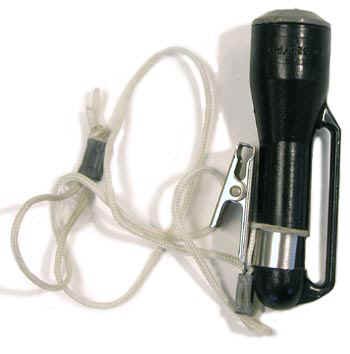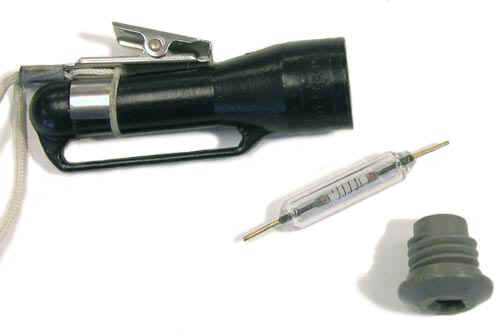Navy DT-526/PD Dosimeter (ca. 1970s)
This is a bulb-type TLD dosimeter used by the U.S. Navy. Harshaw's commercial version is the Model 4040. The CaF2:Mn bulb dosimeter was first described in 1960 by James Schulman of the US Naval Research Laboratory. Schulman, who patented the bulb dosimeter, also developed the Navy's DT-60 radiophotoluminescent (RPL) dosimeter. The DT/526/PD itself was developed by Art Lucas at Harshaw in 1970. Lucas had the honor of sending Schulman his one and only royalty check ($5,000) for the patent.


Each dosimeter consists of two CaF2:Mn elements encased in a glass bulb. The heating element is a metal strip that is sandwiched between the elements—the elements are held in place by a metal spring (see bottom photo). When a current is applied, the CaF2:Mn is heated.
The case comes with a belt loop which should eliminate any possibility that the dosimeter could be lost. Nevertheless, this example also came with a cord that could be tied to the clothing. As it was explained to me, there was no excuse for a lost dosimeter, even if the sailor went overboard. Apparently, the belt loops were broken often enough that some users employed the cord as insurance.
A special tool, like a five-sided Allen wrench, was used to open the case (see the opening on the gray cap in the lower right corner of the above photo). Since these tools weren't readily available, the dosimeter was said to be "sailor-proof." If you look down the inside of the case, you can see a tin filter that was used to flatten out calcium fluoride's notorious over-response to low energy gamma rays.
The gray cap, which is hollow, contains two sulfur tablets and two indium foils to help estimate the dose following a neutron exposure. In the event of such an exposure, the dosimeter is held up against the probe of an AN/PDR-27. The time after the exposure and the reading are used to determine if the exposure was greater than 25 rad. If necessary, the cap can be opened so that the activity of the activated indium and sulfur can be precisely determined. The indium is used to evaluate the thermal neutron exposure while the sulfur is used to evaluate the fast neutron exposure.
The purpose of the glass bulb was to eliminate the spurious emission of light. It also simplified the handling of the TLD elements. They weren't cheap though.
References
- Art Lucas. Personal communication.
- Harshaw brochure, TLD Materials and Systems July 1977.
- Schulman, J.H. et al. A New Thermoluminescent Dosimeter. Selected Topics in Radiation Dosimetry. Proceedings of a Symposium, Vienna, June 7-11, 1960. IAEA, pages:531-539; 1961.
- Ken Bernritter, personal communication.
